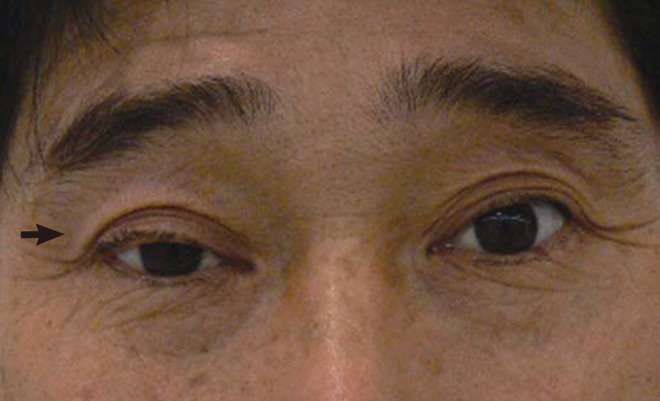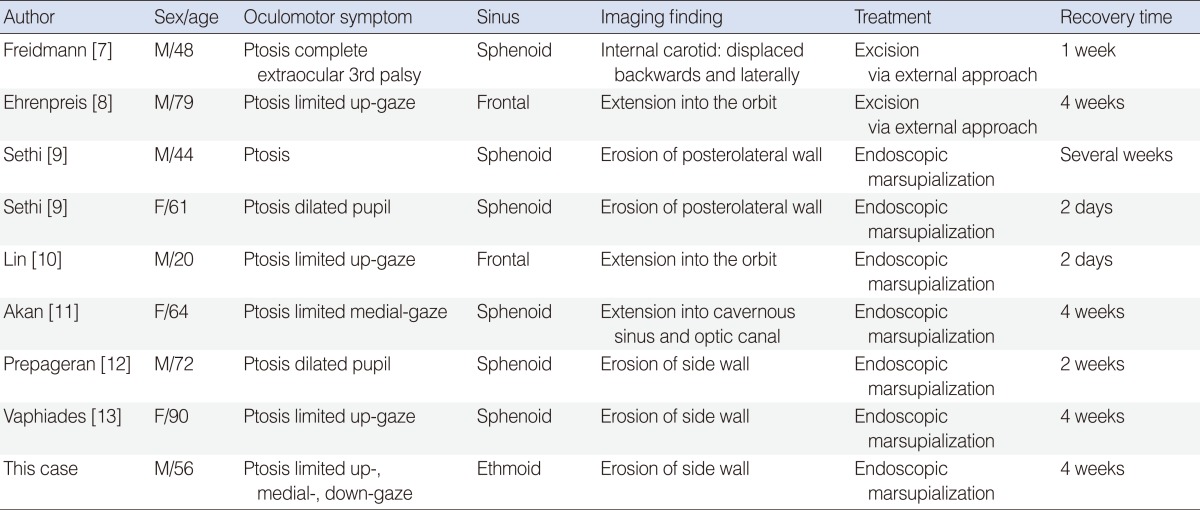1. Kim DY, Kwon BW, Park DE. Clinical evaluation of paranasal sinus mucocele. J Clin Otolaryngol. 2004; 2. 15(1):93–97.

2. Lee KC, Kwon KH, Kang HG, Jin SM, Lee YB. Endoscopic sinus surgery in paranasal sinus mucoceles. Korean J Otolaryngol-Head Neck Surg. 1997; 6. 40(6):855–860.
3. Beasley NJ, Jones NS. Paranasal sinus mucoceles: modern management. Am J Rhinol. 1995; Sep-Oct. 9(5):251–256.

4. Kennedy DW, Josephson JS, Zinreich SJ, Mattox DE, Goldsmith MM. Endoscopic sinus surgery for mucoceles: a viable alternative. Laryngoscope. 1989; 9. 99(9):885–895. PMID:
2770380.
5. Canalis RF, Zajtchuk JT, Jenkins HA. Ethmoidal mucoceles. Arch Otolaryngol. 1978; 5. 104(5):286–291. PMID:
646725.

6. Kim SS, Kang SS, Kim KS, Yoon JH, Lee JG, Park IY. Clinical characteristics of primary paranasal sinus mucoceles and their surgical treatment outcome. Korean J Otolaryngol-Head Neck Surg. 1998; 11. 41(11):1436–1439.
7. Friedmann G, Harrison S. Mucocoele of the sphenoidal sinus as a cause of recurrent oculomotor nerve palsy. J Neurol Neurosurg Psychiatry. 1970; 4. 33(2):172–179. PMID:
5443476.

8. Ehrenpreis SJ, Biedlingmaier JF. Isolated third-nerve palsy associated with frontal sinus mucocele. J Neuroophthalmol. 1995; 6. 15(2):105–108. PMID:
7550927.

9. Sethi DS, Lau DP, Chan C. Sphenoid sinus mucocoele presenting with isolated oculomotor nerve palsy. J Laryngol Otol. 1997; 5. 111(5):471–473. PMID:
9205613.

10. Lin CJ, Kao CH, Kang BH, Wang HW. Frontal sinus mucocele presenting as oculomotor nerve palsy. Otolaryngol Head Neck Surg. 2002; 5. 126(5):588–590. PMID:
12075238.

11. Akan H, Cihan B, Celenk C. Sphenoid sinus mucocele causing third nerve paralysis: CT and MR findings. Dentomaxillofac Radiol. 2004; 9. 33(5):342–344. PMID:
15585814.

12. Prepageran N, Subramaniam KN, Krishnan GG, Raman R. Ocular presentation of sphenoid mucocele. Orbit. 2004; 3. 23(1):45–47. PMID:
15513020.

13. Vaphiades MS, Roberson GH. Sphenoid sinus mucocele presenting as a third cranial nerve palsy. J Neuroophthalmol. 2005; 12. 25(4):293–294. PMID:
16340496.

14. Soon SR, Lim CM, Singh H, Sethi DS. Sphenoid sinus mucocele: 10 cases and literature review. J Laryngol Otol. 2010; 1. 124(1):44–47. PMID:
19825255.

15. Kumagai M, Hashimoto S, Suzuki H, Matsuura K, Takahashi E. Orbital apex syndrome caused by sphenoethmoid mucocele. Auris Nasus Larynx. 2003; 8. 30(3):295–297. PMID:
12927296.

16. Ayberk G, Ozveren MF, Yildirim T, Ercan K, Cay EK, Koçak A. Review of a series with abducens nerve palsy. Turk Neurosurg. 2008; 10. 18(4):366–373. PMID:
19107682.
17. Lin JY, Lin SL, Chang YL, Lo SH, Chuang FS, Lin SY. Sphenoid sinus mucocoele presenting with optic neuropathy and abducens palsy: a late complication of radiotherapy to the head and neck. Eye (Lond). 2005; 6. 19(6):697–699. PMID:
15332102.

18. Kimakura M, Oishi A, Miyamoto K, Yoshimura N. Sphenoethmoidal mucocele masquerading as trochlear palsy. J AAPOS. 2009; 12. 13(6):598–599. PMID:
19879786.

19. Johnson LN, Hepler RS, Yee RD, Batzdorf U. Sphenoid sinus mucocele (anterior clinoid variant) mimicking diabetic ophthalmoplegia and retrobulbar neuritis. Am J Ophthalmol. 1986; 7. 102(1):111–115. PMID:
3728609.






 Citation
Citation Print
Print




 XML Download
XML Download